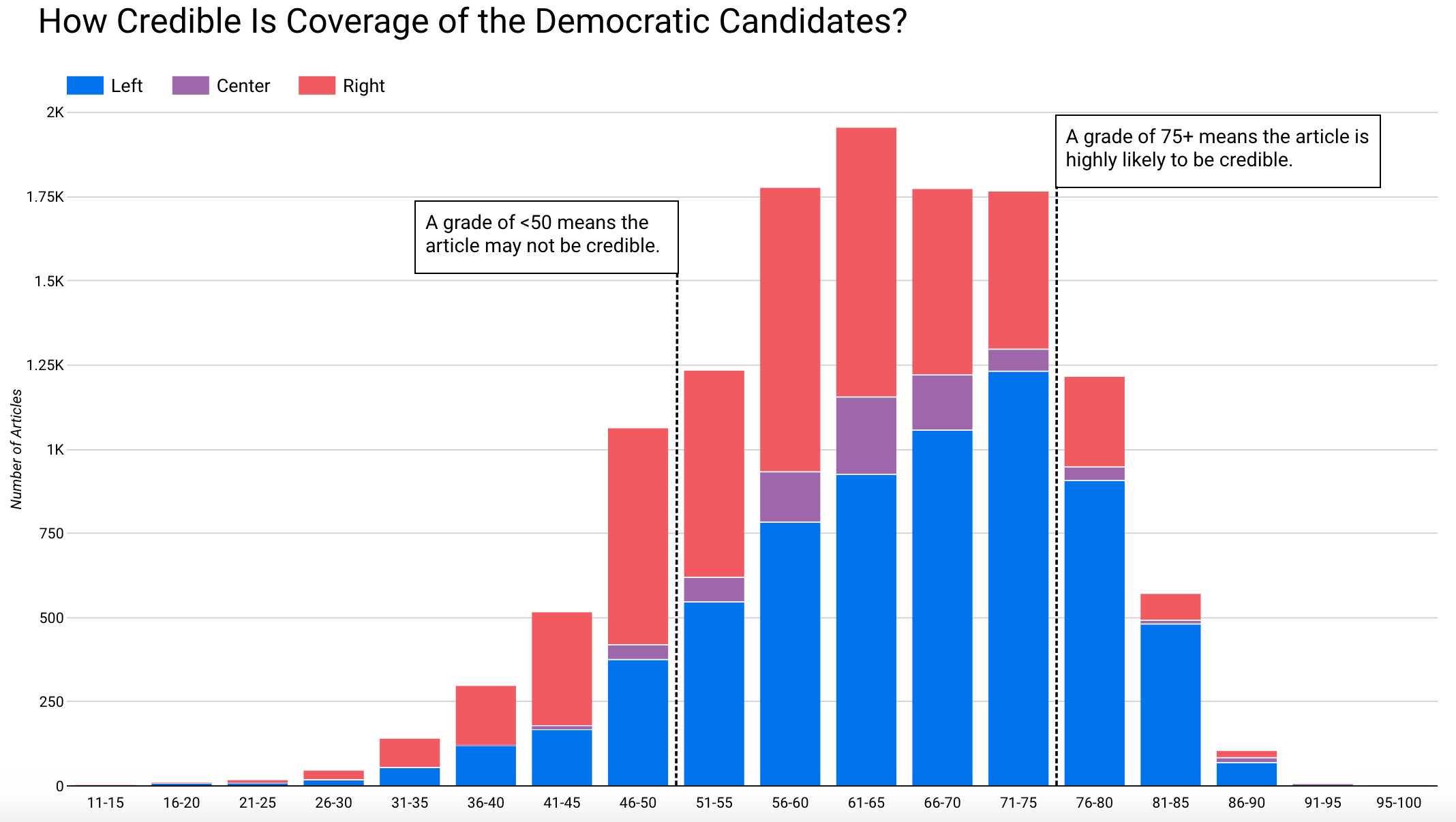Many Americans get their news from places like CNN, Fox News, USA Today, or Breitbart, often exclusively from just one source. But what if many of the articles from these news outlets suffer from a significant lack of credibility? What does this mean for you and for society, particularly as we head into the 2020 election cycle?
By our metrics, many of the most popular news outlets do a lackluster job of substantiating their articles. For example, when it comes to articles about the Democratic presidential candidates, The Factual’s credibility algorithm produces low average scores for some Americans’ top news sources. CNN scored 56%, Fox News scored 58%, and Yahoo News scored just 55%. Yikes. Prominent newspapers score somewhat better, but still not all that high: New York Times (72%), Wall Street Journal (68%), Washington Post (68%), and USA Today (63%).
And while the polarization of the media is not new, it is getting worse. A recent Pew Research report reveals a media landscape where voters on the left and right trust almost entirely different sets of sources, and that “partisan polarization in the use and trust of media sources has widened in the past five years.”
In the context of the Democratic primaries, that means competing sets of information — much of it of questionable quality — about who the Democratic candidates are, what they want, and how they intend to achieve those goals. With this schism in mind, we looked at 54,000 articles across more than 1,300 media outlets over 4 months (October 2019-January 2020) to see which ones offer the most credible, well-resourced coverage of the candidates.
Our goal is to be transparent about how The Factual scores articles for credibility because the last thing the public needs is another “black box” algorithm that pushes news articles without any rationale for why. Below is an explanation of how our scoring works, what our data indicates, and how it can help you find better news in 2020.
How does The Factual grade article credibility?
Every day, The Factual crawls the world’s top news sources to find the most credible, well-resourced articles. Each article receives a score based on four metrics: the site quality, the author’s expertise, the quality and diversity of sources, and the tone of the writing. Each of these metrics answers key questions about the reliability of the article.
- The site quality: Does this site have a history of producing well-sourced, credible articles?
- The author’s expertise: Does the author have a track record of creating credible journalism on the topic? Does the author focus on the topic and hence have some expertise there?
- The quality and diversity of sources: How many unique sources and direct quotes were used in the article? What is the credibility of those sources?
- The article’s tone: Was the article written in a factual tone or was it more opinionated?
These four metrics combine to give a single percentage grade, which we interpret as the probability of the article being credible. Grades above 75% can be regarded as highly likely to be credible. Articles that score below 50% are less likely to be credible and may require cross-checking with better-rated sources to confirm their substance.
The Factual has graded 7 million articles for credibility over the last two years, which produces a frame of reference for the grades it assigns to articles. Because the algorithm functions without human input and because ratings for outlets are built almost entirely on the quality of past articles, The Factual can offer a sober assessment of the credibility of news articles in just seconds using standardized metrics. However, keep in mind that The Factual cannot always obtain scores for articles, and that may have an impact on our data; for more on the these limitations, as well as how we classify outlets by political bias, see our FAQ.
With the above guideposts and limitations, we set out to see just how credible coverage of the Democratic candidates is.
Please check your email for instructions to ensure that the newsletter arrives in your inbox tomorrow.
Top Three Outlets on the Left and the Right
Within our data set from October through January, we found over 12,500 articles directly related to the candidates, including 6,762 from outlets classified as Left or Moderate Left, 4,952 from outlets classified as Right or Moderate Right, and 804 articles from outlets classified as strictly in the center.
The average article scored just 62.7%.

So, not only are there a lot of articles out there, there’s a lot of poorly substantiated ones, too. Moreover, the scarcity of output from outlets in the center offers one more illustration of just how polarized the media environment has become. That makes finding trusted sources harder, regardless of your political outlook.
With that in mind, here are the top three sources on the Left and the Right from our data on coverage of the Democratic candidates. We’ve included one outlet with a high publication frequency on both sides (ideal choices for news lovers seeking up-to-the-minute updates). Each selection also includes a top-scoring story related to the primary race so that you can see how each source might help you stay informed as the primaries really get underway.
And because The Factual is all about finding credible sources across the political spectrum — from the left, the right, and anywhere in between — there is something for everyone.
On the Left
As the Pew Research report discusses, voters on the Left have more options when it comes to news sources and are generally more likely to trust a higher number of sources. We looked at 81 outlets left of center, each of which published 83 articles on average about the candidates over the time period. Outlets classified as Left scored an average of 63%, while outlets rated as Moderate Left scored an average of 67%.
Here are our top performers:
The Intercept
Political Leaning – Left
Average Grade – 78%
Articles Analyzed – 46
Recently in the news itself because of the (spurious) criminal charges levied against a co-founding editor by Brazil, The Intercept launched in 2014 with a self-avowed mission to hold “the powerful accountable through fearless, adversarial journalism.” By our metrics, it has one of the highest average credibility scores.
Top article: Speaking at a K Street Lobby Powerhouse, Joe Biden Renewed His Medicare for All Feud with Elizabeth Warren
(Grade: 90%)
Vox
Political Leaning – Left
Average Grade – 77%
Articles Analyzed – 170
Similarly founded in 2014, Vox has distinguished itself as a Left-leaning media outlet that strives to provide explanatory context to the news. Their focus is not just on the what, but also on the how and why of daily news.
Top article: Sex workers are in danger. Warren and Sanders are backing a bill that could help.
(Grade: 90%)
High output:
CNBC
Political Leaning – Moderate Left
Average Grade – 73%
Articles Analyzed – 315
For those readers on the Left looking to stay on top of up-to-the-minute updates, CNBC proved to be the highest performing outlet on the Left with a large output of stories.
Top article: Andrew Yang: What good are record-high profits if we have record-high stress, anxiety, student loan debt
(Grade: 87%)
On the Right
Our data set included 64 outlets right of center, each publishing an average of 140 articles about the Democratic candidates over the time period. Articles from Moderate Right outlets scored an average of 65%, while articles from Right outlets scored just 56%.
Here are our top picks:
Reason
Political Leaning – Moderate Right
Average Grade – 71%
Articles Analyzed – 85
Self-styled as the magazine of “free minds and free markets,” Reason is an outlet for top Libertarian news and thought, trying to position itself between the Right and Left.
Top article: Bernie Sanders Blames Apple for Silicon Valley’s Government-Created Housing Crisis
(Grade: 86%)
The Federalist
Political Leaning – Right
Average Grade – 69%
Articles Analyzed – 112
Those looking for more conservative takes on the Democratic candidates will find the The Federalist as a good place to start. The online magazine is also a recent entrant to the media landscape, launching in 2013, and espouses “a small-c conservatism equipped with a populist respect for the middle class.”
Top article: How Elizabeth Warren Just ‘Swift Boated’ Herself on Health Care
(Grade: 90%)
High output:
Washington Examiner
Political Leaning – Moderate Right
Average Grade – 71%
Articles Analyzed – 880
The Washington Examiner serves as a counterpoint to prolific left-leaning outlets like CNBC and ABC News and also has one of the highest credibility scores for Right-leaning outlets. Coming from within the Beltway, the newspaper is a useful resource for conservative viewpoints on the pulse of Washington politics — not to mention election season.
Top article: Two French economists from Berkeley advise Warren and Sanders on wealth tax
(Grade: 88%)
Please check your email for instructions to ensure that the newsletter arrives in your inbox tomorrow.
What can you do to stay informed?
In an ideal world, we would all browse highly credible sites across the political spectrum regularly. But that takes time and is impractical for most. So what’s a better solution?
The Factual analyzes thousands of articles every day and curates the most credible stories on the most widely reported topics into a daily email newsletter. Subscribe to The Factual for free and get credible perspectives from a wide range of sources on the most important news topics. Aside from The Factual, there are several other top newsletters that also offer good news analysis.
If you already have news sites you prefer, install The Factual’s Chrome extension so you can see which are the best articles on your favorite sites.
If you get your news on Twitter, we’ve created a Twitter list with the six sources above so you can get credible news across the political spectrum in your feed.
Our goal is to build a news environment where readers have the tools to consistently find the best-resourced news. From there, we can start to have more informed discussions about our communities and the world.

